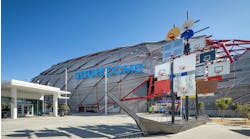Latest from Green
Sponsored
In May of this year, Mechanical Service Contractors of America introduced its GreenStar program, a certification program that's similar to the association's MSCA Star program. The program, in fact, was rolled out during an MSCA Star Summit Meeting. GreenStar is a great idea and we're pleased to announce that W.E. Bowers Inc., Beltsville, Md., is the first contractor to earn the designation.
One of the keys for Bowers is its membership in the U.S. Green Building Council since 2007. The company currently is involved in several LEED EB projects in the Washington metropolitan area, including the headquarters building of the National Geographic Society, the first building to obtain LEED EB certification in 2003.
What I really want to call attention to here is that the MSCA GreenStar program has criteria that a contractor must meet. First, a contractor has to achieve MSCA Star status. MSCA Star is a qualification program that recognizes contractors who meet or exceed rigorous operating and training standards set by MSCA. In addition, to become a GreenStar, an MSCA Star contractor must meet the following criteria:
-
Employ at least one LEED Accredited Professional
-
Be a member of the USGBC — either with a local chapter or the national organization
-
Verify that at least 25% of its total employees have participated in a green training or education program
-
Demonstrate that it promotes environmental responsibility by offering specific sustainable services and recommending green procedures and equipment
-
Establish an internal commitment to green by attaining LEED certification, of any type, for its building, or by developing an internal “green policy”
-
Have participated as part of a project team with a LEED EB or LEED NC registered project within the past three years
GreenStar applications are reviewed and approved by a third-party independent company, not the association. MSCA's criteria determines who is a green contractor. We've been talking with industry people about what constitutes green. There's several criteria.
For example, we report in this issue (California Passes Green Statewide Building Code) that the state of California has published the nation's first statewide green building code. One part of the code outlines what a hot water distribution system should look like.
The code states, “Hot water distribution systems should minimize the amount of water that goes down the drain by using methods or features such as an on-demand hot water recirculation system; a point-of-use hot water system; a centrally located water heater to minimize the length of piping between the fixtures and water heater; hot water piping sized to meet the minimum pipe size diameters allowed by the California Plumbing Code; and a hot water distribution system designed to keep all hot water piping runs as short as possible.”
So does that mean that recirculating hot water systems are green? What if the pipe isn't insulated? What if the pump runs all day? Are radiant floor systems green? Even if they're badly controlled? How many times do you flush a 1.28-GPF toilet before it's no longer high-efficiency? Is a variable speed hydronic circulator green? Even if the manufacturer's rep shows up in a Hummer? I'm writing this in a hotel room where my packet of coffee claims that it, “Contains 35% Rainforest Alliance Certified Coffee.” So does that mean the other two-thirds of the coffee harms the rainforest?
Actually, there's a real answer to the question on the variable speed hydronic circulator. There's a rating system for circulators in Europe.
European headquartered manufacturers might want to think about bringing some form of the rating and certification systems with which they have experience in Denmark or Germany over here. There's no need to reinvent the wheel. They could get together and run a rating program that's been modified for the American market through the Air-conditioning, Heating & Refrigeration Institute, which has plenty of experience running certification programs. And I think the Europeans would have to take the lead on this.
We need to get away from claims that a product will earn a LEED point. (None of them will. LEED points are based on a result, such as a 20% reduction in water use. A product can earn LEED points as part of an overall system.) We can get away from claims that a widget is greener than somebody else's.
Robert P. Mader
Bob Mader is the Editorial Director for Penton's mechanical systems brands, including CONTRACTOR magazine, Contracting Business and HPAC Engineering, all of which are part of Penton’s Energy and Buildings Group. He has been with CONTRACTOR since 1984 and with Penton since 2001. His passions are helping contractors improve their businesses, saving energy and the issue of safeguarding our drinking water. He is a graduate of the University of Notre Dame with an A.B. in American Studies with a Communications Concentration.

